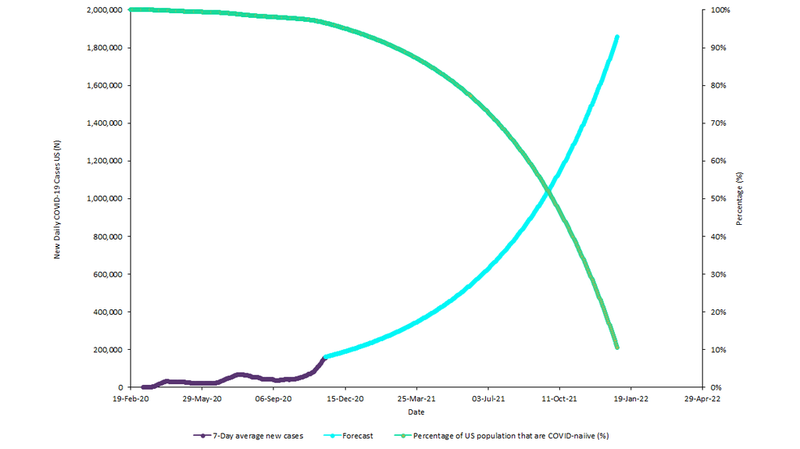US seeing alarming increases in Covid-19 cases; cannot wait on vaccines to curb the pandemic
Covid-19 vaccine trials conducted by Pfizer, BioNTech, and Moderna have released positive findings of vaccine effectiveness in patients in the US. These excellent results from vaccine trails deserve celebration, but Covid-19 statistics in the US remain grim.
Alongside this development, the US reported the highest Covid-19 daily death toll in six months, averaged more than 150,000 new cases daily, and reached over 11.5 million total confirmed cases. According to a GlobalData forecast, if the current trend continues, over 100 million (30%) of the US population may contract the virus through person-to-person transmission by July 2021.
Given that vaccines will need many more months to be approved, manufactured, and distributed to the general population, the US cannot only rely on vaccines to curb the pandemic.
Covid-19 outbreaks have grown at an exponential speed in situations where precautions are not in place or are not effective. Even under a low-level transmission scenario, one hundred cases on Day 1 can grow to 2,200 cases by Day 14 and 45,000 by Day 30.
The US had seen a significant increase in daily new cases in the last month, from around 45,000 daily new cases in early October to around 150,000 daily new cases in early November.
This corresponds to a 0.6% increase in daily cases. GlobalData epidemiologists examined the outcome of the pandemic if current trends continue into 2021 (Figure 1). The forecast model shows that there will be around 200,000 daily new cases by the end of December 2020, and a staggering 675,000 daily new cases by mid-July 2021.
According to an article published on 21 October in Nature about herd immunity, most epidemiological models estimated that around 70% of the population will need to be immune to reach herd immunity, where transmission cannot be sustained due to low numbers of susceptible individuals. However, it is important to understand that waiting for the disease to run its course until herd immunity is reached will result in immense suffering and many deaths.
Herd immunity is a concept that has been developed based on vaccine studies and has never been achieved through infections alone. This scenario also does not include any possible re-infections. As more reports of re-infections have been confirmed, it is likely that the pandemic will last even longer without effective interventions, resulting in even higher numbers of total cases that will cause significant strain on healthcare and disruptions to normal life.
The public must not become complacent after the recent vaccine efficacy announcements, because if the current outbreak situation is not controlled in the coming weeks, many lives will be lost before the vaccines are available to the general public.
Figure 1: US, US, Daily New Cases (N) and Percentage of Population That Are Covid-19 Naïve Forecast, Feb 2020–Dec 2021.

Credit: GlobalData; John’s Hopkins University Covid-19 Database; World Health Organization Covid-19 Situation Reports.
This scenario assumes that current trends in incidence will continue into late 2021. However, given that many cities and states are initiating more lockdown measures, there is hope that the current trend will not continue. While lockdowns are effective in slowing down the rate of infections in the short term, they are harmful to society in numerous other ways and cannot be sustained for long.
In an article published by USA TODAY on 18 November, Dr Anthony Fauci has projected that frontline healthcare workers may receive vaccines as early as the end of December or January, and the general population can expect to receive vaccines by April.
Vaccinated populations will be protected against getting ill and transmitting the virus, and will drastically cut down on the incidence of new infections. However, the US cannot only rely on either lockdowns or vaccines, so the Covid-19 pandemic must be controlled using multiple strategies.
At peak rates earlier this year, the ILI visit rate reached beyond 7%, significantly higher than reported in 2019 at the same time. Based on GlobalData analysis, in 2019 there were 1.39 million lab-confirmed incident cases of influenza and more than 16.6 million cases of influenza-like illness.
Based on the current reported data, it appears that there are fewer cases of ILI than at the same time last year. However, the flu season is only just starting. With healthcare resources stretched thin as a result of the Covid-19 pandemic, the risk of a bad flu season should not be underestimated.
For pharmaceutical industry data, comment and analysis, visit GlobalData's Pharmaceuticals Intelligence Centre.
Market Insight from